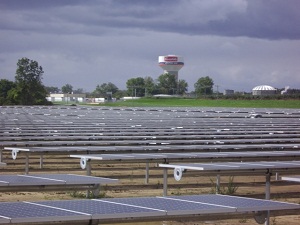Campbell’s condensed solar soup?
 It’s not just Campbell’s Condensed Tomato Soup anymore—it’s Campbell’s Condensed Tomato Solar Soup now that the company decided to install a 2.3-megawatt solar array at its soup and beverage manufacturing facility in Sacramento, Calif.
It’s not just Campbell’s Condensed Tomato Soup anymore—it’s Campbell’s Condensed Tomato Solar Soup now that the company decided to install a 2.3-megawatt solar array at its soup and beverage manufacturing facility in Sacramento, Calif.
It’s the second large solar installation the company’s announced this year as it strives to meet its goal of sourcing 40 percent of its power from clean or renewable sources by 2020.
Under a 20 year power-purchase agreement (PPA) and a land-lease agreement with American Capital Energy (ACE), Campbell will lease out 14 acres of land at its Sacramento facility for the ground-mount array of photovoltaics mounted on trackers and it will buy the power at lower rates than it can get from the local utility, according to Campbell spokesperson John Faulkner.
The array will provide about 10 percent of the facility’s electric needs and while saving roughly $2 million over the life of the PPA. The array in Sacramento will come online in early 2012, Faulkner said.
Earlier this year the company announced a larger, 9.8-megawatt array at its largest site in Napoleon, Ohio.
The Napoleon PV array also is under a PPA. When completed, it will produce about 15 percent of the facility’s energy needs and save it $4 million over the PPA’s lifetime.
“That’s well along; it should be operational in November and fully operational in December,” Faulkner said. “We do these because there’s an economic incentive for us. We can project the savings on our electric costs over the 20-year lifetime.”
The solar installations are also part of the company’s efforts to increase sustainability.
“As part of our strategy, and the way we operate, we want to incorporate sustainable business practices,” he said. “But it must meet the financial hurdles of any capital investment.”
Other commercial food companies like Frito-Lay and Nestle Purina are also adding solar to their manufacturing facilities. Like Campbell, they see solar as a way to help reduce electric costs and become more sustainable.
Image courtesy of Campbell.



